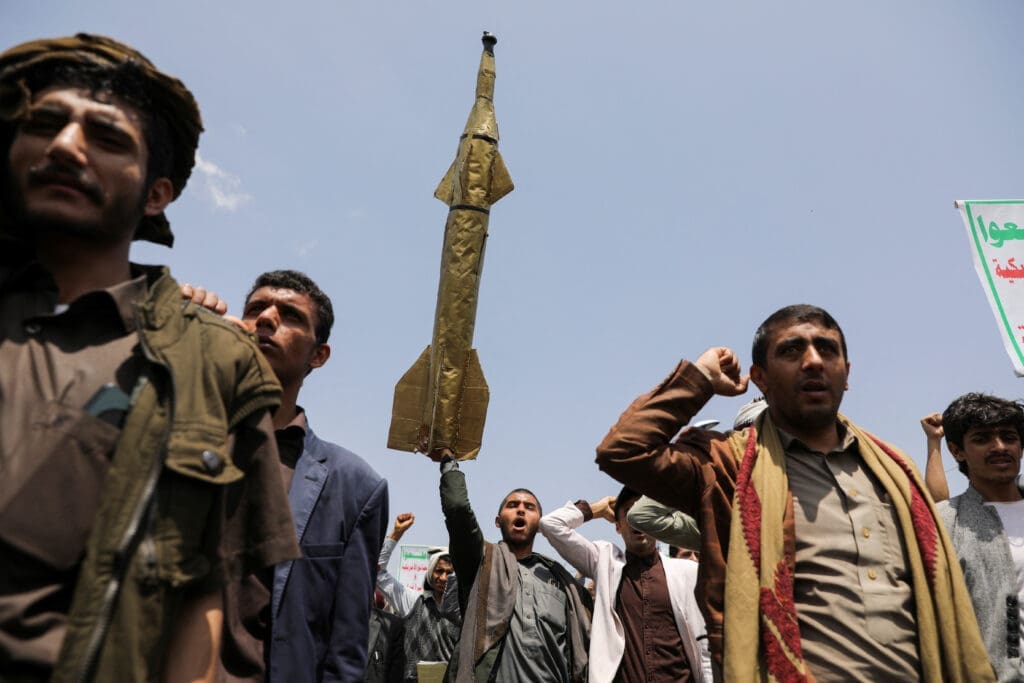For weeks, the Middle East has been on edge as Iran and Lebanon’s Hezbollah prepare to retaliate against Israel for assassinating two high-level figures in their respective capitals, Tehran and Beirut. Frantic diplomacy and renewed momentum around Gaza ceasefire negotiations initially delayed the response, which has the potential to push the region over the brink into full-scale war. But with talks already faltering, a joint strike may be imminent and could also include at least one other party eager for its own payback against Israel: the Yemen-based Houthis.
The direct involvement of the Houthis, otherwise known as Ansar Allah, in the war on Gaza has been one of the more surprising elements of the ten-month old Middle East crisis. Less than two weeks after the start of Israel’s military reprisal on the Gaza Strip that began on October 7, the Houthis launched ballistic missiles and drones in the direction of Israel. Given that the distance from Sanaa to Tel Aviv is more than 2,500 kilometers (1,553 miles), and that the Houthis’ military capabilities are rather limited, the strike appeared more of a performative gesture in solidarity with Hamas and the people in Gaza than a genuine military attack on Israel. Not long after, however, the Houthis began targeting shipping in the Red Sea ostensibly linked to Israel.
This action was far more impactful given the Houthis ability to project force in their own backyard and disrupt the flow of international maritime trade. Indeed, the operations were so successful that the United States navy felt compelled to muster an international naval response starting in January, even bombing Houthi positions within Yemen in the hopes of deterring them. It did not succeed and the Houthis have managed to exact a significant cost on the Israeli economy by cutting access to, and effectively bankrupting, its Red Sea port of Eilat.
More recently, and perhaps consequentially in the long term, the Houthis launched a drone that struck a building in Tel Aviv on July 19, killing one person and injuring at least ten others. Although Israel responded with a massive airstrike on the Yemeni port of Hodeidah and a nearby powerplant, a door was opened that cannot be easily closed. For one, the so-called Axis of Resistance led by Iran has gained a new front for direct attacks on Israel, widening the ambit of conflict in the region to an unprecedented level. Secondly, newer and cheaper technology is narrowing the gap in capability between armed actors, diminishing Israel’s U.S.-sponsored “qualitative military edge.” Despite not having an air force or a navy, this quasi-state actor in the region’s poorest country was able to evade Israel’s sophisticated air defenses and strike deep into the Israeli heartland.
This is a formidable and weighty message to send in a war that is more about strategic and psychological victory and defeat than it is about territorial outcomes. Essentially, Yemen has become one more front that Israel must worry about from an enemy it is unlikely to deter, and one who will continue to build up an arsenal of weaponry it is unafraid to use.
A Deterrent Strike or a Spark for Escalation
Ever since Hamas overran Israel’s heavily fortified Gaza border on October 7, Israeli leaders have been desperate to restore their country’s deterrence. Indeed, Israel’s devastating military campaign in Gaza is, in part, aimed at this goal—an extreme demonstration of its military’s destructive capabilities meant as a warning to others. So too have more surgical strikes in Lebanon, Syria and Iran, where Israel has managed to assassinate top-level adversaries and showcase that it can reach nearly anybody, anywhere—a capability no one else in the region has.
In Yemen, Israel’s reprisal attack on the port of Hodeidah followed a predictable pattern of using disproportionate force against civilian infrastructure, presumably to make the extensive cost a deterrent against future attacks by undercutting support from the civilian population. Yet the efficacy of this longstanding Israeli strategy, which stretches back to the founding of the state, is highly debatable.
Disproportionate attacks on civilian infrastructure are not only illegal under international law but tend to enrage the local population suffering from the attack, and who consequently look to the only party willing and able to strike back—be it Hamas, Hezbollah or, in this case, the Houthis.
In Yemen, Israel’s airforce conducted its operation in a deliberately dramatic way—in broad daylight, with twenty-five F-35 jets following a highly detectable route and targeting fuel storage tanks at a vital port, creating large explosions and prolonged fires, as well as a powerplant 90 kilometers north of that in Al-Salif. Hodeidah is the sole entry point for humanitarian aid to Yemen’s northern regions and the attack could worsen the already dire humanitarian situation there by exacerbating food insecurity and restricting the flow of essential supplies.
But militarily, the Houthis are unlikely to be affected or discouraged from continuing to confront Israel. Months of U.S. strikes and years of Saudi-led coalition bombardment during a prolonged war have failed to do so, demonstrating the Houthis’ high levels of resilience and resolve. Moreover, since intervening militarily against Israel beginning in October, the Houthis have found their domestic, regional and international profile as defenders of the Palestinian cause boosted dramatically. Although the situation in Yemen under Houthi control is far from laudatory, being an active participant in a war against Israel and the United States is a useful projection of power abroad. If anything, Israel’s attack on Yemen is likely to enhance Ansar Allah’s image as a resistance force and give added incentive to carry on the fight.
Undoubtedly, the Houthis face a tumultuous situation inside Yemen that could derail their regional resistance posture. Diplomatic efforts to end the war at home have faltered and violent clashes that had subsided after the UN-brokered truce in 2022 are reemerging in various parts of the country. Tensions between rival central banks have simmered for months and risked pushing the country into further economic collapse. However, after the assault on Hodeidah, the internationally recognized government agreed to de-escalate the situation among the rival banks and ease tensions in other key sectors like transportation.
Finally, Israel appears weaker than ever before. The Houthis and their regional allies see Israel’s increasing dependence on the United States not only for material and diplomatic support, but for its fundamental defense—a stark change from the past.
A Perfect Storm
Israel’s recent decisions—in short order—to carry out strikes in Yemen, Lebanon and Iran have created a coalescing need for retaliation that could finally push the region toward an epic showdown. Much like in April, when Israel bombed Iran’s consulate in Syria, Tehran must respond directly against Israel given the nature of the provocation: the assassination of Ismail Haniyeh, the political leader of Hamas, on an official visit to the Iranian capital. Last time, Iran launched its first direct attack against Israel—sending hundreds of missiles and drones in a highly choreographed demonstration of force that resulted in little actual damage to avoid an escalation. This time, it may need to go a step further, possibly coordinating attacks with Hezbollah and the Houthis to demonstrate a different capability.
After the attack on Hodeidah, the Houthi leader Sayyed Abdulmalik Al-Houthi announced the initiation of the “fifth phase” of the movement’s operations against Israel. He said it included the use of the Jaffa aircraft, the long-range drone it had used to strike Tel Aviv, which he claimed was manufactured in Yemen.
Through these capabilities, the Houthis are showing themselves to be even more useful to Iran than in the past, especially in the current environment in which Tehran needs the multi-node threat against Israel as a deterrent of its own. These developments indicate that the region may be entering a new stage of prolonged conflict, with a heightened risk of widespread regional escalation. This could strengthen cooperation between the Houthis and Iran, providing the Yemeni group with greater military and logistical support.
Given Iran’s historical reluctance for direct retaliation, the Houthis may become Tehran’s secondary means, after Hezbollah, of an indirect response to these attacks. The likelihood of the conflict expanding to include wider regions in the Red Sea and the Gulf of Aden, possibly extending to the Indian Ocean and the Mediterranean Sea, is increasing with significant global economic repercussions. This potential expansion is further supported by the Houthis’ ties with armed groups in the Horn of Africa and Iraq, where one of the group’s military leaders was recently killed, allegedly by an American strike southwest of Baghdad.
However, even if the Houthis do not join the anticipated retaliatory strike against Israel, they have managed to send a regional message that they are a military force that cannot be ignored.



